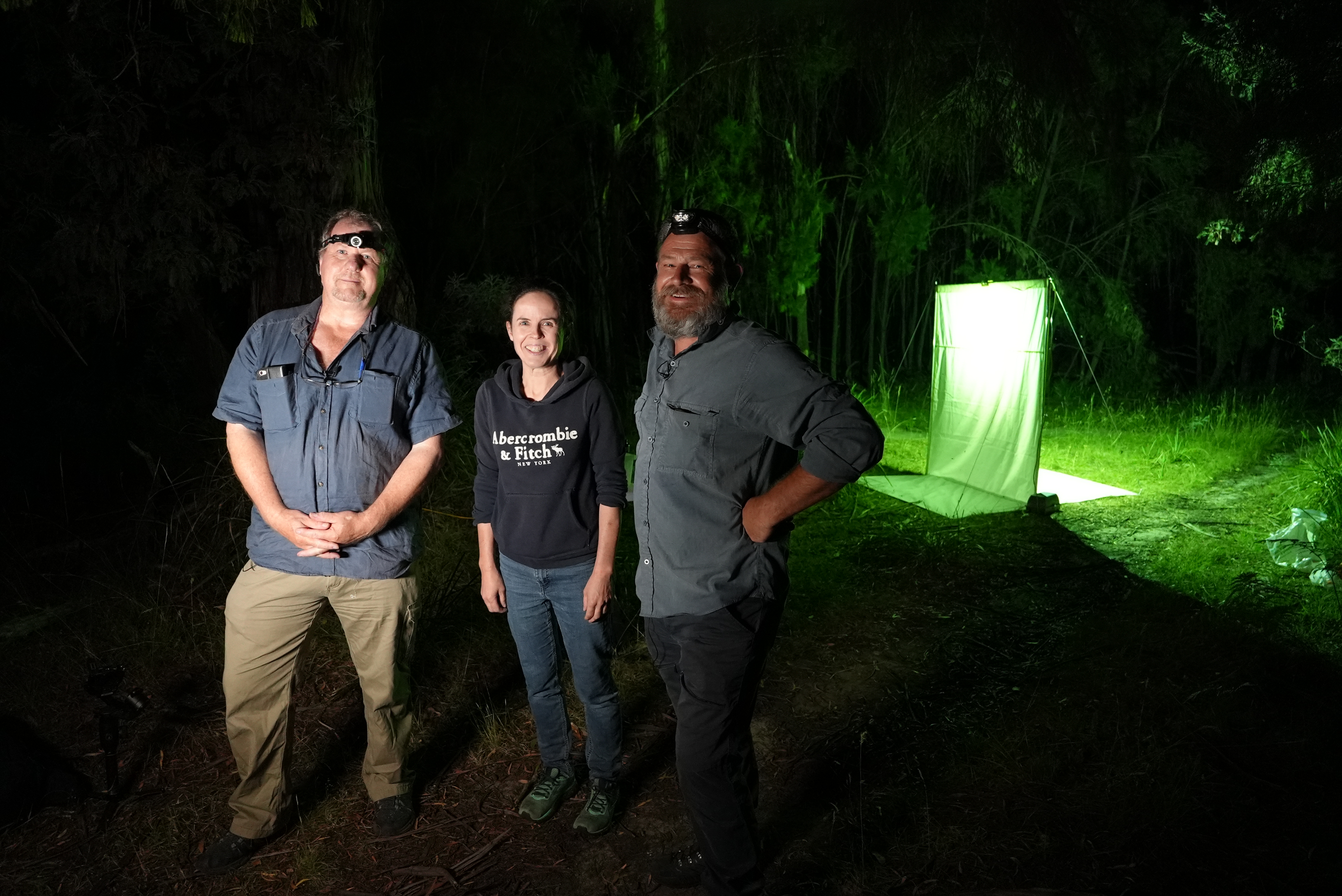Mysterious moths under spotlight at QVMAG
QVMAG Simon Fearn collecting species of moths at night. Image: David Maynard
The mysterious world of moths is being illuminated at the Queen Victoria Museum and Art Gallery as part of Lepidoptera Week Tasmania 2022, with citizen scientists being invited to join a summer moth research project.
'Lepidoptera' is the order of insects which includes butterflies and moths, with the name originating from the ancient Greek for 'scale' and 'wings'.
To celebrate Lepidoptera Week Tasmania 2022, citizen scientists are able to record summer moth observations online at www.inaturalist.org
The QVMAG's Natural Sciences team David Maynard and Simon Fearn said the museum planned to expand its moth collection over the next five years, with the duo having recently undertaken a number of moth collecting adventures around Tasmania.
"We have a very large moth fauna here in Tasmania, but a lot of species are poorly known or in fact wholly unknown to science," Mr Fearn said.
"Historically, there's been little surveying of moths in the North of the State so we are filling in geographic blanks, taxonomic blanks and all sorts of other blanks as we seek to build a collection that is a resource for taxonomists into the future.
"There are probably 1500 species of moths in the state and our guess is that around a third of them are not even named. We still don't know how many species of large macro insects there are in Tasmania in the year 2022 — we are finding new ones all the time.
"And it's really important that we try to understand what's out there because if we don't know they exist, we don't know how to manage their ecosystems."
Mr Maynard said moths played a critical role in ecosystems across the globe, including keeping humanity's food supply chain in operation.
"When you walk around outside during the day, you might occasionally see insects flying past," Mr Maynard said.
"But if you could see at night the way you can see in the day, the air would simply be filled with flying insects. All those insects feed an enormous number of creatures, from spiders to bats. Your average bat colony, for example, consumes a couple of tonnes of insects in a single night.
"Something people often don't realise is that many moths are pollinators, like bees.
"They fly around at night drinking nectar from flowers. There are many plants that have very tight symbiotic relationships with moths. There are plants, for example, that can only be pollinated by a single species of moth.
"Even if we just look at moths in the caterpillar stage — every moth has a caterpillar stage, so there are billions and billions of caterpillars.
"There's an enormous variety of things that eat caterpillars. There are hundreds of species of wasps that parasitise caterpillars or feed caterpillars to their larvae. Birds spend most of their time scrounging around in the foliage looking for caterpillars.
"If you took moths out of the system, there would be a rolling cascade of extinctions, from plants through to animals. Everything is linked. And because there are so many unknown species, we don't even have an inkling of all the various roles they fill in the ecosystem."

QVMAG Natural Science team Simon, Kate and David collecting species of moths through evening field work. Image: QVMAG
Mr Maynard and Mr Fearn said collecting moths and other insects for the QVMAG's collection was often an adventure. In 2020, the pair participated in the federally funded species discovery program Bush Blitz, spending 10 days sampling insects and spiders at the Stony Head Military Range in Northern Tasmania.
"We visit some interesting places around the state, and whenever we go and stay anywhere, we always take the light," Mr Fearn said.
"We call it 'light trapping'. Ideally, you need a light that is high in UV, so we use a mercury vapour lamp. Some nights you may not be very successful, but if the conditions are just right, if it's a warm, still night with no moon, things go crazy.
"In three nights last year we collected hundreds of moths from 60 or 70 species, many of which were the first recorded in the region, and a couple that were the first recorded in the state."
Mr Maynard said finding out more about Tasmania's moths could improve future research opportunities for taxonomists, climatologists and even pharmaceutical and agricultural companies.
"Moths play a critical role on our planet, and we're currently in a climate transition period," Mr Maynard said.
"If we get the baseline data now, in another ten years we will be able to look back and see how things have changed, and model what that may mean for the future. So studying insects like moths can help us better understand our planet.
"And in addition to that, because moths are an integral part of our ecosystem here in Tasmania, they can help us better understand our own backyard.
"Finally, these days DNA is hot property. To date, it's mainly been museums and universities that deal with that, but there is growing commercial interest in what is known as 'bio prospecting'. And that means research companies looking for chemicals that may potentially be turned into agricultural products or pharmaceuticals. Because you never know when that newly discovered species contains a molecule that may potentially cure a disease."
Issued Wednesday 2 February 2022.